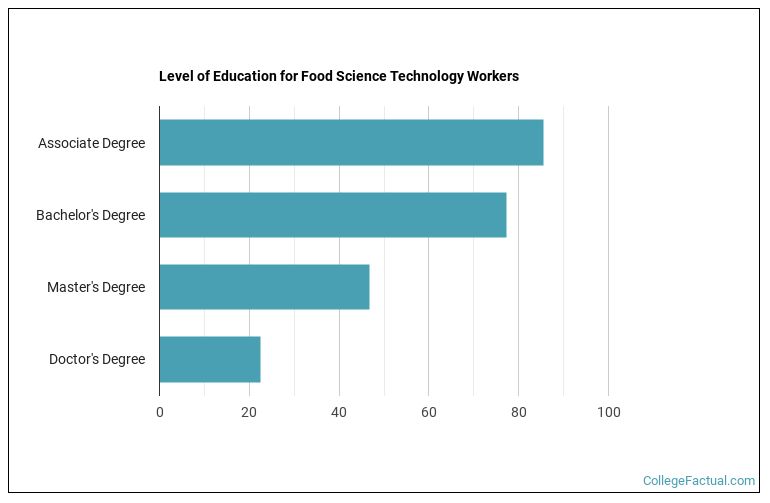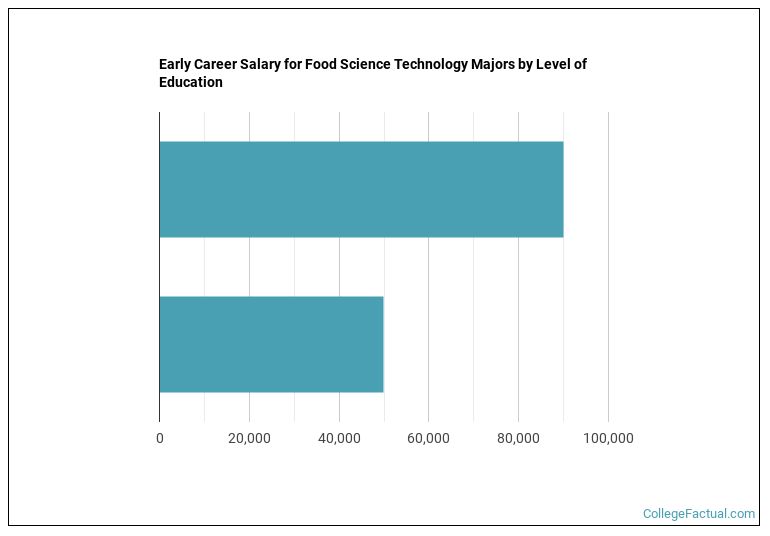 by our College Data Analytics Team
by our College Data Analytics TeamAre you interested in coming up with new foods and flavors? Have you ever wondered why some foods are healthy while others aren't? You may be interested in a career in Food Science Technology.
Food Scientists know everything about food from growing and packaging to manufacturing, distributing, and eventually eating. Food Science Technology majors take classes in biology, chemistry, human physiology, and nutrition to understand agricultural products processing, food additives, food preparation and packaging, storage and shipment. Students also learn how food relates to human health and safety issues surrounding types of fertilizers and other chemicals.
While students have the option to major in Food Science in general, there is the option to specialize on the production process by studying Food Technology and Processing.
Food Science Technology was the 185th most popular major in the 2021-2022 school year. Colleges in the United States reported awarding 2,397 degrees in this year alone. This year's Best Food Science Technology Schools ranking compares 32 of them to identify the best overall programs in the country. Continue reading to check out one of our many unbiased rankings of food science tech programs later in this article.
Successful food scientists are detail oriented and enjoy collecting and analyzing data. Some of their tasks may include testing food for nutrition and safety or engineering a new crop, so precision is important. Analytical and critical thinking will allow for advancement in this field. Strong science skills, especially in biology and chemistry, are also necessary.
Unlike many careers in agriculture, a career in Food Science Technology will typically have an average 40-hour workweek. Most graduates find work in laboratories, research offices, and in processing plants, which have typical work hours.
Although it is not necessary, an internship in Food Science Technology would be helpful. This will give you the opportunity to work with an established food scientist and experience gathering and analyzing data. It also allows the opportunity to experience the field and decide if this is the right career path.
New students will need to have completed high school or a GED program and each school will have their own minimum GPA and SAT/ACT test requirements. Once you obtain your degree, additional food science tech certifications required to pursue a career in this field.
Food Science Tech degree levels vary. You can get anything from a in food science technology to the highest food science tech degree, a . Depending on the food science technology degree you choose, obtaining your diploma can take anwhere from 1 to 4+ years.
| Degree | Credit Requirements | Typical Program Length |
|---|---|---|
| Associate Degree | 60-70 credits | 2 years |
| Bachelor’s Degree | 120 credits | 4 years |
| Master’s Degree | 50-70 credits | 1-3 years |
| Doctorate | Program required coursework including thesis or dissertation | At least 4 years |
A bachelor's degree is the most common level of education achieved by those in careers related to food science tech, with approximately 29.4% of workers getting one. See the the most common levels of education for food science tech workers below.
| Level of Education | Percentage of Workers |
|---|---|
| Bachelor’s Degree | 30.6% |
| Master’s Degree | 20.4% |
| Doctoral Degree | 14.4% |
| High School Diploma | 9.1% |
| Associate’s Degree (or other 2-year degree) | 8.8% |
About 77.3% of workers in careers related to food science tech obtain at least bachelor's degrees. The chart below shows what degree level those who work in food science technology have obtained.

The education level required is different depending on the food science tech career you are seeking.
Typically, Food Science majors work in research labs or in processing plants. Many students find themselves working for colleges, universities, and professional schools in their labs. Since this is a wide major, there are many career options available to graduates. You will be equipped with extensive knowledge on the chemical makeup of food and how it relates to human nutrition. This opens the possibility of working for both the public and private sector, testing, creating and processing various types of foods.
Want a job when you graduate with your food science tech degree? Food Science Technology careers are expected to grow 6.5% between 2016 and 2026.
The following options are some of the most in-demand careers related to food science technology.
| Occupation Name | Projected Jobs | Expected Growth |
|---|---|---|
| Agricultural and Food Science Technicians | 29,200 | 6.2% |
| Food Scientists and Technologists | 18,000 | 5.9% |
| Agricultural Sciences Professors | 13,600 | 7.9% |
Recently graduated food science technology students earned an average of $54,271 in <nil>. Earnings can range from as low as $24,341 to as high as $92,232. As you might expect, salaries for food science tech graduates vary depending on the level of education that was acquired.

Salaries for food science technology graduates can vary widely by the occupation you choose as well. The following table shows the top highest paying careers food science tech grads often go into.
| Occupation Name | Median Average Salary |
|---|---|
| Agricultural Sciences Professors | $90,890 |
| Food Scientists and Technologists | $72,570 |
| Agricultural and Food Science Technicians | $44,170 |
With over 321 different food science tech degree programs to choose from, finding the best fit for you can be a challenge. Fortunately you have come to the right place. We have analyzed all of these schools to come up with hundreds of unbiased food science tech school rankings to help you with this.
Food Science Technology is one of 18 different types of Agriculture & Agriculture Operations programs to choose from.
| Major | Annual Graduates |
|---|---|
| Food Science | 1,649 |
| Viticulture and Enology | 291 |
| Food Science & Technology, Other | 188 |
| Brewing Science | 109 |
| Food Technology & Processing | 97 |
| Related Major | Annual Graduates |
|---|---|
| Veterinary/Animal Health Technologies/Technicians | 8,951 |
| Animal Science | 8,178 |
| Agricultural Economics & Business | 8,140 |
| Horticulture | 3,591 |
| Veterinary Medicine | 3,468 |
Image Credit: By Muhammad Irshad Ansari under License More about our data sources and methodologies.